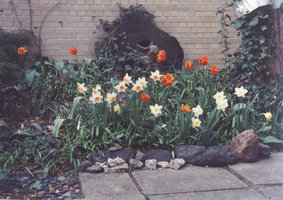





(Editor's Note: This article was originally published on October 28, 2008. Your comments are welcome, but please be aware that authors of previously published articles may not be able to promptly respond to new questions or comments.)
No matter where you live, having detailed knowledge of your yard's nooks and crannies can mean the difference between whether plants thrive or don't even survive. Any weather zone, no matter its extremes, offers sheltering "microclimates" that can mitigate the effects of sun, shade, wind, drought, rain, frost and heat. (Did I miss any of the scourges that affect us gardeners all year long?
Here in northern Illinois, which segues between Zone 5 and Zone 6, depending on your proximity to Lake Michigan, the protection of a house foundation or of an evergreen windbreak may allow you to grow plants that wouldn't make it even a few feet away. And, as fall brings changes in sunlight and temperature, now is a perfect time for you to stroll through the garden and take note of its differences.
You'll need this knowledge in a few months when spring fever hits and lust blooms in your soul -- not for an unsuitable man, but for an unsuitable plant: "Oh! - on the south side of the house, just behind the corner of the entryway, a few feet from the dryer vent, that spot where the late afternoon light reflects off that white shed and the soil drains so well ... couldn't I ... oh, I'll bet .... [fill in the blank here with a plant that is one zone too tender for your garden]."
 In this walled townhouse garden in Chicago, spring bulbs bloomed a full month earlier than normal.
In this walled townhouse garden in Chicago, spring bulbs bloomed a full month earlier than normal.
But, of course, with love comes risk.
Lee Randhava, a respected writer and plant authority at the Chicago Botanic Garden, told me once that she could never, in good conscience, recommend plants that aren't hardy to Zone 5.
But she admitted, probably with her conscience smarting, that temptation sometimes wins out.
"Well, the flowering dogwood, Cornus florida, now that's a plant that grows beautifully on the East Coast but which we can't recommend. Then again, I know people who have them. Keep in mind, though, that the dogwood is an understory tree - it's never planted out in a lawn, but in the edge of a woodland where it's protected."
I myself have a Japanese Pagoda dogwood that has survived one winter already, and it is indeed planted amid a grove of oaks, maples and tulip poplars.
But that's MY yard. So many variables can affect the temperament of a garden; their combined effect can be difficult to gauge. While one building can block a steady wind, several can create a wind tunnel. A south-facing slope has a longer growing season, but you must factor in its greater exposure. And don't forget that frost flows downhill and nestles in that little dip that otherwise seems perfectly protected.
If you have a spot where you're determined to push your zone, Ms. Randhava suggested testing the soil first. For example, the pronounced alkalinity and water-retaining clay found in northern Illinois is not always ideal. Add sulphur twice a year, she said, along with a "tremendous amount of light, friable material such as shredded bark, pine straw, sand or peat moss." (Better drainage improves ANY plant's chances of surviving a spell of adverse weather, and it is key to my raised tulip border pictured above. Too much water is death to dormant tulips.)
Here, too, winds from the Northwest are the most damaging, but it's better to plants evergreens as a windbreak rathen than building a wall or fence. As Ms. Randhava explains it, this allows air circulation, an important consideration, but the shrubs don't reflect heat, which can bring plants out of the ground too early. Tender new growth is more vulnerable to a late cold snap, which can easily kill a plant that otherwise would have survived the winter.
In fact, consistent cold and an insulating snow cover are the best things that your marginal plants could hope for. (I will add that to my wish list.)
In the meantime, as you begin your fall cleanup, watch for those areas where plants survive a light frost. Or perhaps you notice a bed where reflected light brings a late boost to your basil. And as winter waxes and wanes, pay attention to your snow cover. Are there spots where a forgotten cabbage plant begins to head in the spring rather than turning to mush? How about patches where daffodils sprout a week earlier than the rest? That's a sure sign that they are benefiting from something, perhaps heat escaping through your foundation.
Only you can learn your garden's sweet spots -- I invite you to indulge next spring rather than pine for that special plant that seems just out of reach. And let us know how it goes!
I think for me it will be another ‘Tasmanian Tiger' spurge to replace the plant I lost last year. But this time I won't plant it in that lovely sunny border that turned into a windswept wasteland come January.
Copyright © www.100flowers.win Botanic Garden All Rights Reserved